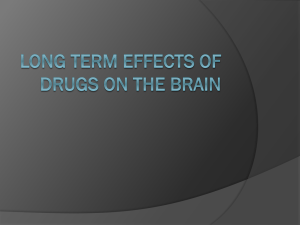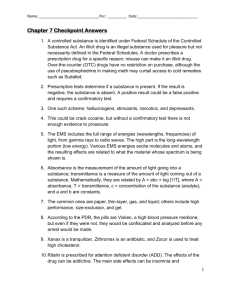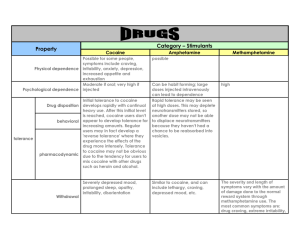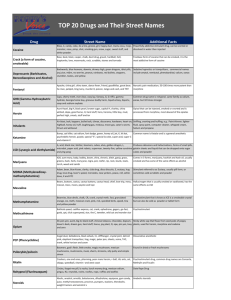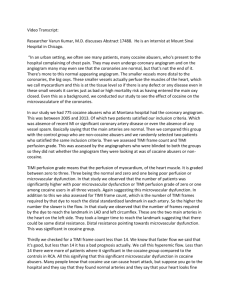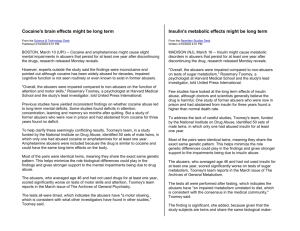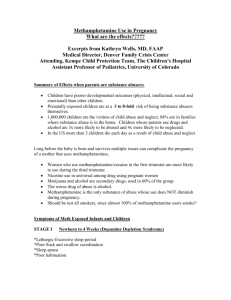Psychometric Profiles of Violent Offenders with Histories of
advertisement
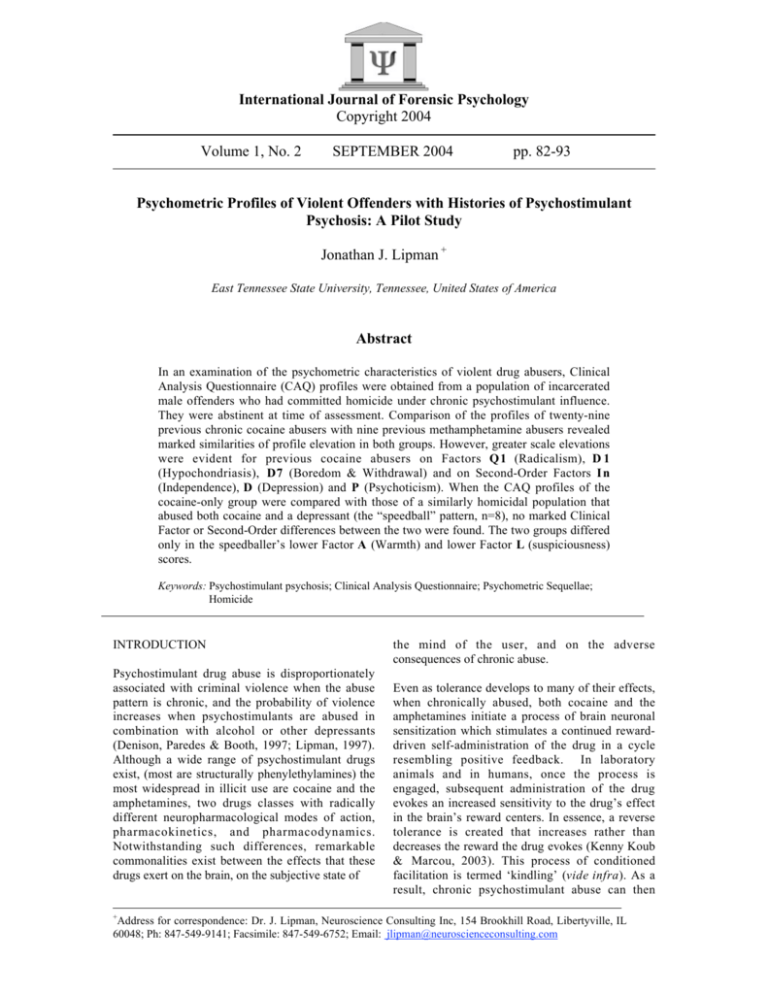
International Journal of Forensic Psychology Copyright 2004 Volume 1, No. 2 SEPTEMBER 2004 pp. 82-93 Psychometric Profiles of Violent Offenders with Histories of Psychostimulant Psychosis: A Pilot Study Jonathan J. Lipman + East Tennessee State University, Tennessee, United States of America Abstract In an examination of the psychometric characteristics of violent drug abusers, Clinical Analysis Questionnaire (CAQ) profiles were obtained from a population of incarcerated male offenders who had committed homicide under chronic psychostimulant influence. They were abstinent at time of assessment. Comparison of the profiles of twenty-nine previous chronic cocaine abusers with nine previous methamphetamine abusers revealed marked similarities of profile elevation in both groups. However, greater scale elevations were evident for previous cocaine abusers on Factors Q 1 (Radicalism), D 1 (Hypochondriasis), D7 (Boredom & Withdrawal) and on Second-Order Factors I n (Independence), D (Depression) and P (Psychoticism). When the CAQ profiles of the cocaine-only group were compared with those of a similarly homicidal population that abused both cocaine and a depressant (the “speedball” pattern, n=8), no marked Clinical Factor or Second-Order differences between the two were found. The two groups differed only in the speedballer’s lower Factor A (Warmth) and lower Factor L (suspiciousness) scores. Keywords: Psychostimulant psychosis; Clinical Analysis Questionnaire; Psychometric Sequellae; Homicide INTRODUCTION Psychostimulant drug abuse is disproportionately associated with criminal violence when the abuse pattern is chronic, and the probability of violence increases when psychostimulants are abused in combination with alcohol or other depressants (Denison, Paredes & Booth, 1997; Lipman, 1997). Although a wide range of psychostimulant drugs exist, (most are structurally phenylethylamines) the most widespread in illicit use are cocaine and the amphetamines, two drugs classes with radically different neuropharmacological modes of action, pharmacokinetics, and pharmacodynamics. Notwithstanding such differences, remarkable commonalities exist between the effects that these drugs exert on the brain, on the subjective state of + the mind of the user, and on the adverse consequences of chronic abuse. Even as tolerance develops to many of their effects, when chronically abused, both cocaine and the amphetamines initiate a process of brain neuronal sensitization which stimulates a continued rewarddriven self-administration of the drug in a cycle resembling positive feedback. In laboratory animals and in humans, once the process is engaged, subsequent administration of the drug evokes an increased sensitivity to the drug’s effect in the brain’s reward centers. In essence, a reverse tolerance is created that increases rather than decreases the reward the drug evokes (Kenny Koub & Marcou, 2003). This process of conditioned facilitation is termed ‘kindling’ (vide infra). As a result, chronic psychostimulant abuse can then Address for correspondence: Dr. J. Lipman, Neuroscience Consulting Inc, 154 Brookhill Road, Libertyville, IL 60048; Ph: 847-549-9141; Facsimile: 847-549-6752; Email: jlipman@neuroscienceconsulting.com Metrics of Violent Psychostimulant Psychosis proceed in sleepless, anorexic and hypomanic ‘runs’ lasting from days to weeks, colored subjectively by the increasing adverse effects of progressive neurotoxic processes. The run is ultimately terminated by a “crash” during which time the user sleeps. Following an acute abstinence period of recovery and recuperation of variable length (usually days), a subjectively depressing subacute withdrawal syndrome and drug craving ensues, which increases in intensity with time. The affective misery of this syndrome is relieved by re-administration of the psychostimulant, which leads to relapse and the engagement of another “run”. The process can repeat for years before circumstances intervene to terminate the repetitive cycle. The most prominent of the adverse effects of chronic psychostimulant abuse is a schizophreniform syndrome that develops gradually in the chronic abuser, evolving into a condition characterized by paranoia, hallucinations, and delusions (Rosse, Collins, Fay-McCarthy et al, 1994). Abstinent persons (that are former abusers) are for a long time thereafter vulnerable to a return to this state with minimal stimulation. The range of schizophreniform symptoms experienced are typified by the findings of Harris & Batki (2000), who report that of a population of 23 stimulant abusing subjects (14 abusing amphetamine, the remainder cocaine) admitted to the psychiatric emergency service at San Francisco General Hospital, 100% suffered persecutory delusions, 89% had delusions of reference, 53% had grandiose delusions, 32% had somatic delusions and 95% had bizarre delusions. Auditory delusions were experienced by 95% and 32% heard voices providing running commentaries, 58% heard two or more voices conversing, 68% had visual hallucinations, 26% had tactile hallucinations and a similar number had olfactory hallucinations. The long-lasting vulnerability to psychotic decompensation on subsequent re-exposure was described initially by Ellinwood et al (1973). Post and Kopanda (1976) subsequently proposed a sensitization model, which posited enduring reduction in sensitivity to the psychotoxic effects of psychostimulants analogous to the sensitization seen with epileptogenic agents. This process thus explains the evolution of the addictive state in response to chronic psychostimulant abuse (supra), and may also explain the enduring vulnerability of the chronic abuser of these drugs to the psychotomimetic – paranoid schizophreniform – state. Termed “limbic ictus” by Monroe (1982), the persistent vulnerability of the subject to paranoid evocation was proposed to involve a reduction in the reactivity of the limbic system, which could at least in part explain the phenomenon of episodic dyscontrol (Monroe, 1985), a fairly common cause of homicide in these cases. Since the vulnerability of the chronic psychostimulant abuser to psychotic decompensation increases with chronic use and persists in abstinence, it is reasonable to suppose that the alterations to the central nervous system subserving this increased vulnerability will, to some measurable extent, globally affect the user’s thoughts, attitudes, and feelings in a way that can be characterized using psychometric testing methods. There is no clear consensus on the duration of such increased vulnerability to psychostimulant-induced psychotic decompensation - in some cases it may be permanent. In other cases the reduction in psychotic threshold opens the user to an emerging psychotic state in the absence of resumed drug administration, an endogenous psychosis. In such individuals, it is not entirely clear at which precise point psychostimulantinduced psychosis becomes schizophrenia. (Flaum & Schultz, 1996). Since severe and chronic drug abuse often involves the abuser in a criminal lifestyle, the arrestee population provides a natural study group for psychometric research that is inherently categorized by intensity of misbehavior. Most studies of personality variables in offender populations have employed the Minnesota Multiphasic Personality Inventory (MMPI) as the objective instrument of assessment. In one of the largest studies of a general inmate sample, Megargee et al (1979) found that the largest of their ten typologies of offenders by MMPI criteria had essentially normal profiles. In yet other reports, MMPI indices have not been found useful in discriminating between different violent offender subgroups (Holland, Beckett & Levi, 1981) or between those who sexually assaulted children (Hall et al, 1986). Quinsey et al (1980) found the MMPI profile to be unrelated to offense category. As has been observed by Tammany, Evans and Barnett (1990), it seems that while the MMPI is useful in identifying the presence of severe pathology, such pathology is not present in most International Journal of Forensic Psychology © 2004 ijfp.psyc.uow.edu.au 83 Lipman, J. inmates. Tammany et al have suggested therefore that research of this type should use objective measures of normal-range personality rather than significant psychopathology, and they employed the 16-PF (Cattell, 1989) for this purpose. Their method examined which 16-PF features, if any, might differentiate one type of offender from another. They found that the 16-PF factors of “Boldness” and “Intelligence” contributed to a significant discriminant function, which, with variables of “age” and “substance abuse history,” correctly classified 42.6% of the inmates into their offense category. Notwithstanding Tammany et al’s limited ability to categorize their subjects by offense category using the 16-PF, Spotts & Shonts (1991) performed a meta-analysis of 16-PF research in nine groups of substance abusing populations (a nonuser comparison group, seven psychiatric groups, a criminal group and a group of gang delinquents). They found that some similarity in 16PF profile could be found among alcoholics, but beyond this, they were unable to conclude that any commonality in 16-PF profile united the substance abusers. Like us, they found that the varieties and combinations of drug abuse styles within populations were hypervariable and inhomogeneous within and between groups, rendering analysis particularly difficult. They suggested that a more fruitful direction of future research might be to use the clinical form of the instrument, the Clinical Analysis Questionnaire (CAQ, Krug, 1980), which is specifically designed to detect psychopathology. Earlier work from this laboratory (Lipman, 2001) built upon Tammany’s work among a single class of drug abusing violent offenders (incarcerated murderers) and sought to identify psychometric characteristics of the murderer’s drug choice as reflected in their personality traits measured by the 16-PF. This earlier analysis addressed the personality profiles of 56 of these male offenders, categorizing their drug use style according to the major drug class whose chronic use was associated with their offense. Using Pearson Product-Moment correlation analysis we found that stimulant abusers as a class were distinguished from other drug abusers by positive correlation on their Factor L (suspiciousness) scores and Factor O (Insecurity) scores and their negative correlation on Factor Q3 (Self Discipline) scores. Their negative correlation on Factor Q2 (Self-Sufficiency) approached, but did not reach, significance. Thus: tested after months and years of abstinence from drugs, these International Journal of Forensic Psychology © 2004 ijfp.psyc.uow.edu.au 84 violent felons retained paranoid and schizotypal patterns of responding as measured by the 16-PF. Against this background, this present study was undertaken as a pilot to employ the CAQ to compare and contrast the CAQ personality profiles of murderers whose offenses were determined, by interview and evidence review, to be behaviorally related to the psychopathology of their stimulant drug abuse, either amphetamine or cocaine. METHOD Of a total population of 82 drug-abusing male murderers surveyed, 46% were polydrug abusers at the time of their offenses, but from among the group as a whole, 38 were solely abusing psychostimulants, either cocaine (the Cocaine-only group, n=29) or amphetamine (the Amphetamineo n l y group, n=9) and had been arrested for homicide whilst experiencing a chronic psychostimulant toxicity state. All had been drug abstinent by self-report for a period of time ranging from several months to several years following arrest and incarceration. A further subgroup of eight cocaine abusers also coadministered a depressant drug with their cocaine (the “Cocaine+depressant” group). “Cocaineo n l y ” abusers were aged 32 ± 9 years and “Amphetamine-only” abusers were aged 34± 8. All the Amphetamine-only drug abusers were white, as were 13 (44%) of the Cocaine-only group, which also had 5 (17%) Hispanics and 11 (37%) black members. Administration routes of abused cocaine in the Cocaine-only group were: smoking (n=14), snorting (n=10) and intravenous (n=5). The Amphetamine-only group was non-injecting and all abused the methamphetamine salt: all took the drug orally and six also snorted, and three smoked, the drug. In the Cocaine+depressant group (n=8), 3 coadministered heroin, 1 used oxycodone, 3 abused alprazolam and 1 abused diazepam, 5 were black and 3 white. The Clinical Analysis Questionnaire (CAQ) was administered as part of a forensic neuropharmacological evaluation of the subjects, advised consent being first obtained for their participation in this study. A structured interview technique was employed to ascertain the chronology, intensity and pattern of the subject’s drug use, the drug effects history, and the relationship of these to age and life events. On the basis of the interview, subjects were categorized as to their principle lifetime drug Metrics of Violent Psychostimulant Psychosis pattern and their drug abuse type during the time of their offense, the latter being the subject of the present study. Alcohol use was common to both cocaine abusers and methamphetamine abusers represented in the present cohorts, as has been reported by others (Harris & Batki, 2000). CAQ questionnaires were administered to the subjects as the paper-and-pencil forms and were hand scored by the author and assistants. Sten (standard ten) scores were derived, and SecondOrder Factors calculated, using Normal Male Norms (Krug, 1980, table 2.2) to derive the transformations. Sten-transformed data were then databased in SAS StatView for further analysis. Symptom validity measures of the CAQ are provided by the Faking Good (FG) and Faking Bad (FB) scales, which are themselves sten-transformed before their corrections are applied to the remainder of the scales of the CAQ. Sten scores provided below are therefore faking-corrected on a case-by case basis if the faking sten score (either FB or FG) met or exceeded the individual’s correction threshold of Sten 7. RESULTS Validity measures (sten mean ± SD) for the experimental groups were as follows: Cocaine-only group FB=6.50±1.4, FG=4.19±1.97; Amphetamine–only FB=5.88 ± 2.70, FG = 5.63 ± 1.30; Cocaine+depressant FB=7.71 ± 2.64, FG =5.36 ± 2.10. The CAQ presents the psychometric profile in three sections: (1) the Normal Personality Traits are the 16 factors common to the 16-PF test, derived from responses to a battery of 175 questions, (2) the Clinical Factors are 12 separate scales derived to detect psychopathology, from responses to an additional 144 questions, and (3) the Second-Order Factors are a derivative scale which are weighted composites of responses on the first two scales. In the tables and figures herein the CAQ Factors are described by their abbreviation designations, and the factor names are therefore provided in Table 1. Sten scores (Mean ±SE) for the CAQ factors of the three drug abuser groups are provided in Table 2. Since the sten transformation of the raw scores applies normalization to the score, these data are nonparametric. Statistical comparisons between the Cocaine-only group, the Amphetamine-only group, and between those of the Cocaine-only group and the Cocaine+depressant group therefore employed the Mann-Whitney U-test. Probability values associated with the values of U derived from pairwise comparisons are given also in Table 2. Our data are graphically illustrated in Figures 1 to 4. Table 1 Factor names of the three portions of the Clinical Analysis Questionnaire (CAQ) NORMAL PERSONALITY TRAITS A Warmth B Intelligence C Emotional Stability E Dominance F Impulsivity G Conformity H Boldness I Sensitivity L Suspiciousness M Imagination N Shrewdness O Insecurity Q1 Radicalism Q2 Self-sufficiency Q3 Self-discipline Q4 Tension CLINICAL FACTORS SECOND ORDER FACTORS D1 D2 D3 D4 D5 D6 D7 Pa Pp Sc As Ps Ex Ax Ct In Se So D P Ne Hypochondriasis Suicidal depression Agitation Anxious depression Low energy depression Guilt & resentment Boredom & withdrawal Paranoia Psychopathic deviation Schizophrenia Psychasthenia Psychological inadequacy Extraversion Anxiety Tough Poise Independence Superego strength Socialization Depression Psychoticism Neuroticism International Journal of Forensic Psychology © 2004 ijfp.psyc.uow.edu.au 85 Lipman, J. Table 2 Sten values (Mean ± SE) of CAQ factors measured in male murderers abstinent from their chronic cocaine abuse (Cocaine only, n= 29), chronic amphetamine abuse (Amphetamine only, n=9) or abuse of cocaine combined with a depressant (Cocaine+DEP, n= 8). AMPHET only v COCAINE only AMPHETAMINE only COCAINE only COCAINE+DEP COCAINE only v COCAINE+DEP MANN-WHITNEY MEAN SE MEAN SE MEAN SE MANN-WHITNEY FACTOR A B C E F G H I L M N O Q1 Q2 Q3 Q4 p-value 0.6430 0.8808 0.5485 0.5823 0.3771 0.5709 0.4533 0.0512 0.7642 0.9336 0.3593 0.5709 0.0290 0.8545 0.2937 0.8285 4.00 5.22 4.22 5.00 4.78 5.56 4.00 6.00 6.33 4.11 5.56 6.89 4.56 6.67 5.00 7.33 0.24 0.66 0.64 0.97 0.68 0.73 0.82 0.76 0.75 0.51 0.56 0.74 0.71 0.71 0.55 0.62 5.43 4.93 3.87 5.53 5.47 4.80 4.80 7.43 6.47 4.33 6.40 7.57 6.40 6.77 4.47 7.53 0.40 0.33 0.43 0.43 0.45 0.35 0.44 0.29 0.37 0.40 0.47 0.34 0.33 0.44 0.40 0.36 3.50 5.00 3.75 5.00 5.88 3.75 4.13 7.75 5.00 4.25 5.50 7.25 5.75 8.00 4.63 8.00 0.46 0.27 0.62 0.60 0.61 0.68 0.90 0.62 0.38 0.56 0.78 2.49 1.01 0.66 0.78 0.50 p-value 0.0277 0.5667 0.9145 0.4850 0.8579 0.1974 0.4521 0.7609 0.0331 0.9287 0.4850 0.9003 0.6545 0.2101 0.5789 0.6545 D1 D2 D3 D4 D5 D6 D7 Pa Pp Sc As Ps 0.0164 0.0597 0.6171 0.2641 0.0989 0.4736 0.0420 0.1566 0.5175 0.1096 0.2787 0.0372 5.78 6.22 5.22 6.56 6.67 7.79 5.44 7.56 4.89 7.22 6.89 6.44 0.80 0.94 0.78 0.94 0.67 0.72 0.82 0.63 0.75 0.68 0.81 0.71 7.97 8.07 4.83 7.83 7.97 8.50 7.07 8.53 4.40 8.40 7.87 8.03 0.27 0.31 0.48 0.37 0.22 0.30 0.33 0.25 0.44 0.30 0.36 0.30 7.25 6.75 5.13 8.13 7.25 9.00 6.63 7.50 5.50 8.13 7.38 7.75 0.59 0.94 0.99 0.97 0.59 0.68 0.89 0.60 0.87 1.73 0.82 0.59 0.2519 0.1794 0.8299 0.3902 0.2748 0.2670 0.6805 0.1071 0.2594 0.6288 0.6162 0.6674 Ex Ax Ct In Se So D P Ne 0.7139 0.9734 0.0668 0.0266 0.3421 0.3421 0.0136 0.0404 0.1770 4.33 7.69 5.79 4.29 5.40 5.73 5.99 6.32 6.44 0.80 0.63 0.72 0.50 0.72 0.41 0.94 0.92 0.51 4.73 7.63 4.43 5.90 4.73 6.17 8.37 8.40 5.77 0.39 0.33 0.30 0.34 0.32 0.39 0.24 0.31 0.29 3.75 7.87 3.88 6.38 3.88 5.00 7.38 8.13 6.38 0.84 0.64 0.35 0.71 0.77 0.95 0.73 0.58 0.60 0.2519 0.7337 0.2748 0.5192 0.2374 0.2519 0.2037 0.5309 0.2235 Note. = p<0.05, Mann-Whitney U-Test International Journal of Forensic Psychology © 2004 ijfp.psyc.uow.edu.au 86 Metrics of Violent Psychostimulant Psychosis Figure 1. Sten scores (Mean ± SE) of the CAQ Normal Personality Traits measured in chronic cocaineonly abusers (Cocaine, dark columns) and in chronic amphetamine-only abusers (Amphetamine, light columns). p<0.05, Mann-Whitney U-Test. Broken horizontal lines at Sten 4.5 and 6.5 indicate the normal range of variation (5.5 ± 1.0 SD) of the mean of the normalized sten scores. The Clinical Factor scores of Cocaine-only and Amphetamine-only groups are illustrated in Figure 2. As with the Normal Personality trait scores, the general shapes of the profiles were comparable, and cocaine abusers again scored higher than amphetamine abusers, although this difference was significant only for Factors D1 (Hypochondriasis, p=0.016), D7 (Boredom & Withdrawal, p<0.05) and P s (Psychological Inadequacy, p<0.05). C o c a i n e - o n l y abusers thus endorsed CAQ responses indicating that they were more preoccupied with ill health and bodily dysfunctions than Amphetamine-only abusers, felt more reclusive and avoidant, and suffered more reality distortions in the area of self-worth than did amphetamine abusers. The Second-Order Factor sten scores of the two groups of psychostimulant abuser are illustrated in Figure 3. Here the profile patterns of the two groups differed qualitatively. Amphetamine-only abusers scored higher than Cocaine-only abusers on Factor Ct (Tough Poise), although this difference did not reach a level considered significant statistically (p=0.067). Lower scores on Factor Ct – as for the Cocaine-only abusers - indicate an emotional reactivity and vulnerability to being easily swayed by feelings. Second-Order factor scores of Cocaine-only abusers were, however, significantly higher than A m p h e t a m i n e - o n l y abusers on Factor I n (Independence, p=0.026), Factor D (Depression, p=0.014) and Factor P (Psychosis, p=0.04). Cocaine-only abusers thus profiled as being more self-reliant, less controlled by others, more melancholic, sad, and withdrawn than A m p h e t a m i n e - o n l y abusers and suffering significantly more disorganized and psychotic thought than these amphetamine abusers. International Journal of Forensic Psychology © 2004 ijfp.psyc.uow.edu.au 87 Lipman, J. Figure 2. Clinical Factor Sten scores (Mean ± SE) of chronic cocaine- only abusing (cocaine, dark columns) and chronic amphetamine-only abusing (amphetamine, light columns) groups, p<0.05, MannWhitney U-Test, see text and legend to Figure 1 for additional explanations. International Journal of Forensic Psychology © 2004 ijfp.psyc.uow.edu.au 88 Metrics of Violent Psychostimulant Psychosis Figure 3. Second Order Factor Sten scores (Mean ± SE) of cocaine-only abusing subjects (Cocaine, dark columns) and amphetamine-only abusing subjects (Amphetamine, light columns). p<0.05, MannWhitney U-Test Comparison of cocaine-only versus cocaine +depressant history respects the two groups were (statistically) very similar. The CAQ profiles of the Cocaine-only abuser group, compared with the Cocaine+depressant group, are illustrated in Figure 4. It is apparent that the two groups did not differ significantly on any Factor except Factor A (Warmth, p<0.05) and Factor L (Suspiciousness, p<0.05). In all other The combination Cocaine+depressant users as a group were thus more reserved, detached and aloof than the cocaine-only group, and they were more trusting and adaptable than the Cocaine-only group. They were otherwise equally paranoid and schizotypal as assessed by their Clinical Factor and Second-Order factor scores (p>0.05). International Journal of Forensic Psychology © 2004 ijfp.psyc.uow.edu.au 89 Lipman, J. Figure 4. CAQ Sten scores (Mean ± SE) of the chronic cocaine-only group (cocaine, dark columns) and the cocaine+depressant group (Dep+Cocaine, light columns), p<0.05, Mann-Whitney U-Test. CONLCUSIONS AND DISCUSSION The major shortcoming of the present study is the small group sizes, particularly of the Amphetamineo n l y and the Cocaine+depressant c o h o r t s , increasing the risk that differences observed due to chance alone could be erroneously attributed to the effect of prior drug abuse (a source of error that applies even to larger groups). These findings should therefore be regarded as preliminary. This having been said, the main conclusions drawn from the comparisons are largely those of similarity, not of difference, a potentially important finding regarding the commonality of the psychometric sequellae of the abuse of psychostimulants when these are abused repetitively and cyclically to and beyond the point of paranoid psychosis. The present findings do not provide any support for the hypothesis that an abuse history of Cocaine+depressant use (the “speedball” pattern of abuse, see Lipman, 1997) produces or is associated with psychometric residua that are different in any major way from the abuse of Cocaine only. Both are equally ‘abnormal’ with elevated Second-Order Factor P (Paranoia) and Second-Order D International Journal of Forensic Psychology © 2004 ijfp.psyc.uow.edu.au 90 (Depression) scores. Both show equal elevations on Factor Sc (Schizophrenia). Consistent with the observations of Tammany et al (1990), the Normal Personality Trait profiles (common to the 16PF that Tammany employed) of the cocaine and the amphetamine abusers were very similar, differing in the present case in this sample only on the Factor Q1 (Radicalism) dimension. The groups differed significantly on Second-Order In (Independence), D (Depression) and P (Psychoticism) Factors. Cocaine abusers scored significantly higher on these Second-Order axes, which are derivative from the Normal Personality Traits and the Clinical Factors, in which the Cocaine-only group scored generally higher on all scales than the Amphetamine-only group and significantly different on Factors D1, D7 and Ps. More so than the Amphetamine-only abusers, therefore, Cocaine-only abusers were withdrawn, solitary, joyless, and had significant somatic concerns. Quantitatively, the greatest Clinical Factor difference between the two groups occurred on Factors D1 and D7. According to Krug (1980), schizophrenics tend to score highest of the clinical groups on Factor D7. In our data, Factor Sc scores of both C o c a i n e - o n l y and Amphetamine-only Metrics of Violent Psychostimulant Psychosis groups were both elevated above the normal rangeand were not different from each other statistically. High scoring individuals on Factor S c have endorsed responses indicating they had difficulty getting their ideas into words, had strange impulses, and felt that the world is unsympathetic and felt rejected by others. Such individuals experience memory lapses, feelings of unreality and have hallucinations and beliefs incongruent with those of others. The item content on Factor Sc is more bizarre than on other scales and whilst a high score on Factor D7 indicates interpersonal withdrawal, elevation on Factor Sc indicates a more extreme withdrawal from reality. The present study begins to address, in part, a deficiency in the published research literature pertaining to drug abuser populations tested using the 16PF or the CAQ, in that earlier work with these scales has not adequately addressed the different types of drug abuser as distinct entities. In the vast majority of reports, exemplified by the CAQ manual itself (Krug 1980) and more recently by a meta-analysis performed by Spotts & Schontz (1991), abusers of the widely different pharmacological drug classes are unceremoniously lumped together as “narcotics abusers.” Yet, even within this profound limitation, “narcotics abuse” has been shown to correlate with psychopathology as indexed by the Normal Personality Traits, a conclusion that we would extend to the present findings using the CAQ, most particularly with regard to the cocaine abusing groups, either alone or coadministering depressants. Without actually administering a ‘run’ of psychostimulant drugs to the individuals of this study – which would be ethically questionable and certainly impractical given their custodial status – there is no way that we can determine the extent to which the presently described psychometric anomalies that characterize these groups index their present vulnerability to psychotic decompensation. The phenomenon of increased vulnerability to such psychosis on relapse of psychostimulant abstinence is, however, well studied ecologically. Thus: Sato et al (1983), reporting from Japan, followed one hundred and eleven patients diagnosed with chronic methamphetamine abuse who had been admitted to mental hospitals in the Okayama region. Sixteen of these individuals relapsed after various intervals of between 1 and 60 months and experienced an acute exacerbation of a paranoid state almost identical in presentation to the initial psychotic episode, four of these after a single drug administration A contributor to any biological basis of the similarity in enduring psychometric abnormality due to the psychostimulants may reside in the commonalities of these different drugs’ enduring neurotoxicities on brain function arising from each their separate chronic abuse. Ernst et al (2000) used Proton Magnetic Resonance Spectroscopy (1HMRS) to study the brains of 26 abstinent chronic methamphetamine abusers, 13 of each gender, and to compare these with 24 normal volunteers (12 male, 12 female). 1H-MRS was employed to quantitate three signals: those of the neuronal marker, N-acetylaspartate [NA], that of the glial marker myoinositol [MI] and of a choline [CHO] signal believed to index cell membrane turnover. In the methamphetamine abstinent group they found a significant 6% reduction of NA signal in the frontal lobes of the brain and a significant 5% reduction in the basal ganglia. The frontal white matter NA was found to correlate inversely with the logarithm of the duration of the subject’s methamphetamine abuse. The signals from CHO and MI were both increased in the areas of the brain demonstrating reduced NA signal: the MI signal reduced by 11% in frontal white matter, indicating a gliosis in the regions revealing reduced neuronal signal, which was accompanied by increased membrane turnover (CHO signal) in these regions. A similar study by these authors on 64 abstinent chronic cocaine abusers had earlier compared with 58 healthy controls, revealing similar effects in these same frontal regions, and in areas projecting to these frontal regions (Chang et al, 1999). These neurotoxic effects due to the abuse of psychostimulants are therefore demonstrably persistent and are common to both cocaine and the amphetamines. Correlated not only with the abovementioned neuronal loss, but also with persistently reduced frontal lobe cerebral blood flow, neuropsychological tests also index subtle behavioral indicia of chronic abuse in the abstinent state: those with a prior history of methamphetamine abuse perform slower than normals on certain tests of a computerized battery, even while scoring in the normal range of overall neuropsychological function (Chang et al 2002). A definitive study by Toomey et al (2003), using separated twins in which one member was drug free and the other abused psychostimulants (cocaine or amphetamine) has recently revealed that deficits in International Journal of Forensic Psychology © 2004 ijfp.psyc.uow.edu.au 91 Lipman, J. attention and motor skills persist after 1 year of abstinence from stimulant use. It must be remembered that our subjects were all pre-selected for study by virtue of their history of homicidal violence under psychostimulant influence. Neuropharmacological laboratory studies by others performed on amphetamine administered to normal volunteers tested before and following 5 and 10 mg doses have shown significant psychoticism x d-amphetamine interactions for both drug doses: d-amphetamine increases energetic arousal and hedonic tone, and reduces tense arousal, but only in individuals classed as “low psychoticism” as defined psychometrically. In “high psychoticism” individuals, the drug led to lowered energetic arousal and hedonic tone, and increased tense arousal (Corr & Kumari, 2000). The possibility exists therefore that the present population is not representative of a wider class of psychostimulant abusers, which may contain larger numbers of less vulnerable and less psychotic subjects. It follows from our and others’ findings, however, that those subjects who have previously experienced chronic psychostimulant psychosis appear to remain idiosyncratically predisposed to vulnerability to the phenomenon, a vulnerability which colours their thought processes and cognitive style as estimated by psychometric measures. Whether this represents a pre-drug susceptibility they brought to the experience or is entirely a residuum of the neurotoxic state itself remains to be determined. REFERENCES Cattell, H.B., (1989) The 16 PF: Personality in depth. Champaign, Illinois: Institute for Personality and Ability Testing (pubs). Chang, L., Ernst T., Speck, O., Patel, H., DeSilva, M., Leonido-Yee, M., Miller, E.N., (2002). Perfusion MRI and computerized cognitive test abnormalities in abstinent methamphetamine users. Psychiatry Research. 2002 Jun 15; 114(2), 65-79. Chang, L. Ernst, T., Strickland, T., and Mehringer, M.S., (1999). Gender effects on persistent cerebral metabolite changes in the frontal lobes of abstinent cocaine users. American Journal of Psychiatry, 156(5), 716-722. International Journal of Forensic Psychology © 2004 ijfp.psyc.uow.edu.au 92 Corr, P.J., Kumari, V.(2000). Individual differences in mood reactions to d-amphetamine: a test of three personality factors. Journal of Psychopharmacology. 14(4), 371-377. Denison, M.J., Paredes, A. & Booth, J.B. (1997). Alcohol and cocaine interactions and aggressive behaviors. In: Galanter, M. (ed), R e c e n t developments in alcoholism, Volume 13: Alcohol and Violence. NY: Plenum Press Ellinwood, E.H. Jr., Sudilovsky, A., Nelson, L.M. (1973). Evolving behavior in the clinical and experimental amphetamine (model) psychosis. American Journal of Psychiatry, Oct; 130(10), 1088-93. Ernst, T., Chang L., Leonido-Yee, M., Speck, O. (2000). Evidence for long-term neurotoxicity associated with methamphetamine abuse: A 1HMRS study. Neurology, Mar. 28; 54(6), 1344-9. Flaum, M., Schultz, S.K., (1996). When does amphetamine-induced psychosis become schizophrenia? American Journal of Psychiatry, June; 153(6), 812-5. Hall, G.C.N., Maiuro, R.D., Vitalliano, P.P., & Proctor, W.C., (1986). The utility of the MMPI with men who have sexually assaulted children. Journal of Consulting & Clinical Psychology, 54, 493-496. Harris, D. and Batki, S.L. (2000). Stimulant psychosis: symptom profile and acute clinical course. American Journal of Addiction, Winter; 9(1), 28-37. Holland, T.R., Beckett, G.E., & Levi, M, (1981), Intelligence, personality and criminal violence: A multivariate analysis. Journal of Consulting & Clinical Psychology, 49,106-111. Kenny, P.J., Koob, G.F., Markou, A. (2003). Conditioned facilitation of brain reward function after repeated cocaine administration. Behavioral Neuroscience, Oct; 117(5), 1103-7. Krug, S.E. (1980) Clinical Analysis Questionnaire Manual. Champagne, Illinois: Institute for Personality and Ability Testing, (pubs). Metrics of Violent Psychostimulant Psychosis Lipman, J.J., (1997). Recent Forensic Pharmacological Developments in Drug Abuse: The growth and problems of speedballing. Forensic Examiner, 6 (7-8), 9-13. Lipman, J.J. (2001). Personality Drug Abuse and Murder: A pilot Study, Forensic Examiner, 10 (1 & 2), 20-26. Megargee, E.I., Bohn, M.J., Meyer, J.E., & Sink, F. (1979). Classifying criminal offenders: A new system based on the MMPI. Beverly Hills, California: Sage (pubs). Monroe, R.R. (1982). Limbic ictus and atypical psychoses. Journal of Nervous and Mental Disease, Dec; 170(12), 711-6. Monroe, R.R. (1985). Episodic behavioral disorders and limbic ictus. Comprehensive Psychiatry, 1985 Sep-Oct; 26(5), 466-79. Post, R.M., Kopanda, R.T. (1976). Cocaine, kindling, and psychosis. American Journal of Psychiatry, 1976 Jun; 133(6), 627-34. Quinsey, V.L., Arnold, L.S. & Preusse, M.G., (1980). MMPI profiles of men referred for pretrial psychiatric assessment as a function of offense type. Journal of Clinical Psychology, 36, 410-417. Rosse, R.B., Collins, J.P. Jr., Fay-McCarthy, M., Alim T.N., Wyatt, R.J., and Deutsch, S.I., (1994). Phenomenologic comparison of the idiopathic psychosis of schizophrenia and druginduced cocaine and phencyclidine psychoses: a retrospective study. Clinical Neuropharmacology, 1994 Aug; 17(4), 359-69. Tammany, J.M., Evans, R.G., and Barnett, R.W. (1990). Personality and intellectual characteristics of adult male felons as a function of offense category. Journal of Clinical Psychology. 46(6), 906-911 Toomey, R., Lyons, M.J., Eisen, S.A., Xian, H., Chantarujikapong, S., Seidman, et al (2003). A twin study of the neuropsychological consequences of stimulant abuse. Archives of General Psychiatry, Mar; 60(3), 303-10. International Journal of Forensic Psychology © 2004 ijfp.psyc.uow.edu.au 93

